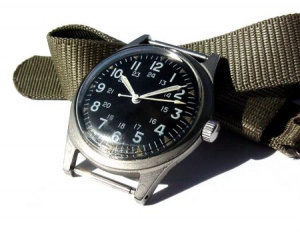GG-W-113 Military Watch

GG-W-113 Military Watch
US Military Issue
GG-W-113 was a spec released in 1967 and was issued concurrently for many years. The differentiation was that it featured exclusively a 17-jewel, manual-wind and hacking movement and a “sterile” dial for legibility. These watches were meant for issue to pilots and were produced by Benrus, Hamilton, Marathon, and Altus. They were produced between 1967 and the late 1980’s, when quartz movements began to gain popularity and start replacing mechanical models. They were utilized most prominently in the Vietnam War, but may also have been deployed in conflicts within the Persian Gulf and other middle eastern theatres.
Technical Requirements
- A mechanical movement with an accuracy of +- 30 seconds per day
- 17 Jewels
- A hacking mechanism
- Shock resistance (must survive a fall from 4 feet onto a wooden block)
- Waterproofness
- Luminous Hands (using Tritium)
- Antimagnetic
- Minimum of 36 hour power reserve
There is generally some confusion between the GG-W-113 specification and its predecessor, the MIL-W-3818B. Although both of these watches look nearly identical, the GG-W-113 was issued to military pilots while the MIL-W-3818B was issued to troops on the ground. The MIL-W-3818B movement was generally considered lower quality, and differed primarily in its jewel count. Additionally, some of the field troop models lacked a hacking movement.
All of these watches will bear case back markings with contract type, federal stock number, manufacturing part number, contract number, manufacture month and year, and serial number. These marking make it easy to identify the manufacturer and year of issue.
The dial layout for the various incarnations of this watch is extremely sterile, with some manufactures names on dial markings (see the Marathon’s dial). A classic black dial with 12 hours in arabic numerals, an inner ring marking 24-hour time, and a 60-increment seconds index with darts indicating the hour positions. At 34-35mm, they are relatively small by modern standards, but have ample wrist presence due to their lug length and high domed crystals.
Luminous hands were produced using radioactive Tritium (hydrogen 3). On vintage examples of this watch, the luminescent material is generally no longer glowing.
The cases on these watches were stainless steel, generally with a matte or parkerized finish. “Parkerization” is a method of protecting a steel surface from corrosion through the application of a chemical phosphate conversion. These finishes were more durable, less reflective, and generally better suited for military application as they held up better in extreme weather and under heavy use.
Hamilton GG-W-113
- Size: 34mm x 18mm
- Movement: 17 Jewel ETA 2750 (Hamilton Cal 649)
- Year: 1967 - 1986
- Depth Rating: 30M
Benrus GG-W-113
- Size: 34mm x 18mm
- Movement: 17 Jewel ETA 2750 (Benrus Cal GY1L2)
- Year: 1967 - 1986
- Depth Rating: 30M
In addition to the military issue GG-W-113, Benrus also produced a civilian version that is known to collectors as the “Bullitt”. The “Bullitt” Benrus 3061 was famously worn by Steve McQueen in the 1968 movie of the same name, gracing the wrist of the San Francisco cop “Frank Bullitt” as he raced around the streets in his dark green Ford Mustang GT. This model is easy to differentiate by noting its red-tipped seconds hand.
Marathon GG-W-113
- Size: 36mm x 17.6mm
- Movement: 17 Jewel ETA-2801-2 (Gallet)
- Year: 1984 - 1986
- Depth Rating: 30M
Glycine Altus GG-W-113

- Size: 36mm x 17.6mm
- Movement: 17 Jewel ETA-2801-2 (Gallet)
- Year: 1986
- Depth Rating: 30M
Links
- US Armed Forces Issued Watches
- MIL-W-3818B Military Watch
- MIL-W-46374 Military Watch
- Benrus
- Altus
- Military Watches
- Main Page
Credits - https://www.60clicks.com/gg-w-113-pilot-watch-buyers-guide/
